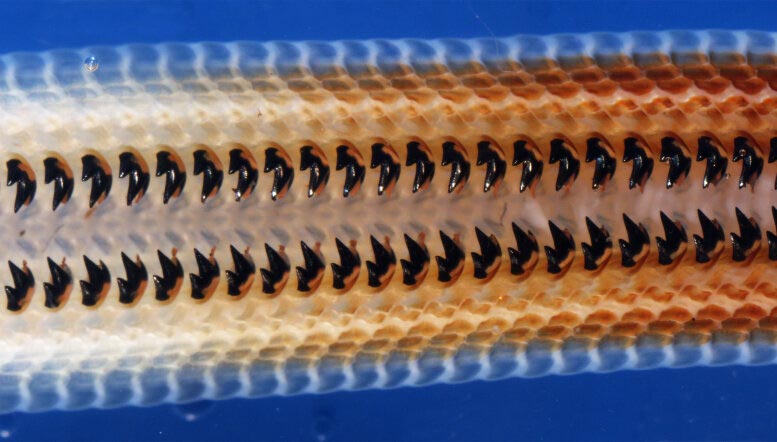
A section of a radula from Crytochiton stelleri, showing its hard, durable teeth. Credit: Northwestern University
Rare Mineral From Rocks Found in Mollusk Teeth
Northwestern University researchers have, for the first time, discovered a rare mineral hidden inside the teeth of a chiton, a large mollusk found along rocky coastlines. Before this strange surprise, the iron mineral, called santabarbaraite, only had been documented in rocks.
The new finding helps understand how the whole chiton tooth — not just the ultrahard, durable cusp — is designed to endure chewing on rocks to feed. Based on minerals found in chiton teeth, the researchers developed a bio-inspired ink for 3D printing ultrahard, stiff and durable materials.
“This mineral has only been observed in geological specimens in very tiny amounts and has never before been seen in a biological context,” said Northwestern’s Derk Joester, the study’s senior author. “It has high water content, which makes it strong with low density. We think this might toughen the teeth without adding a lot of weight.”
The study will be published this week in the Proceedings of the National Academy of Sciences.
Joester is an associate professor of materials science and engineering in Northwestern’s McCormick School of Engineering and a member of the Chemistry of Life Processes Institute. Linus Stegbauer, a former postdoctoral fellow in Joester’s laboratory, is the paper’s first author. At Northwestern during the research, Stegbauer is now a principal investigator at the Institute of Interfacial Process Engineering and Plasma Technology of the University of Stuttgart in Germany.
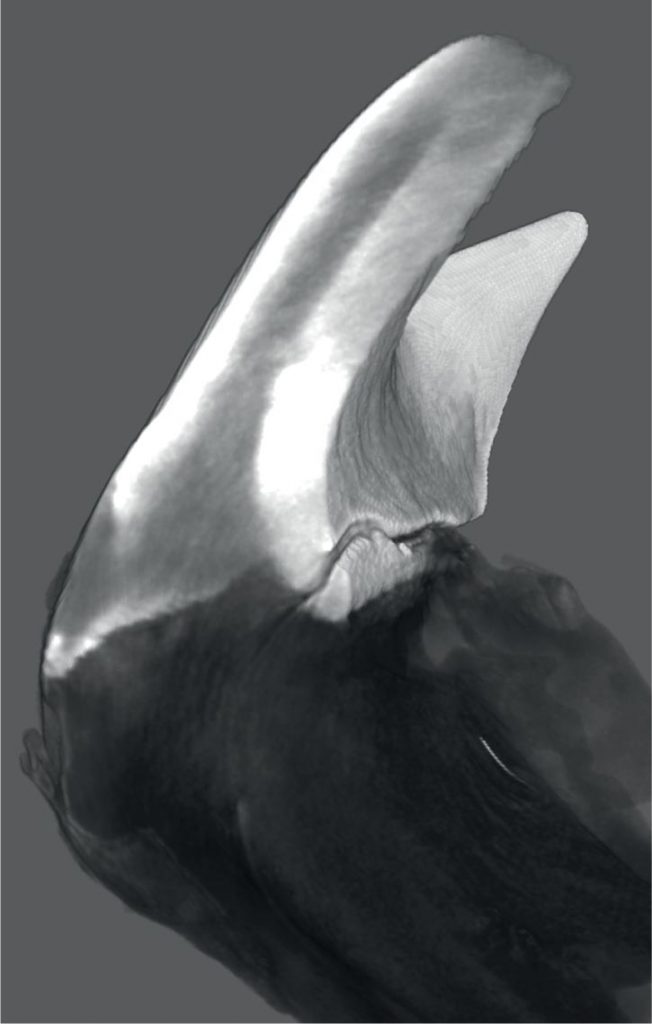
Rendering of a virtual section of a single tooth head and upper stylus, generated from a 3D reconstruction as determined by synchrotron microcomputer tomography. Credit: Northwestern University
One of the hardest known materials in nature, chiton teeth are attached to a soft, flexible, tongue-like radula, which scrapes over rocks to collect algae and other food. Having long studied chiton teeth, Joester and his team most recently turned to Cryptochiton stelleri, a giant, reddish-brown chiton that is sometimes affectionately referred to as the “wandering meatloaf.”
To examine a tooth from Cryptochiton stelleri, Joester’s team collaborated with Ercan Alp, a senior scientist at Argonne National Laboratory’s Advanced Photon Source, to use the facility’s synchrotron Mössbauer spectroscopy as well as with Paul Smeets to use transmission electron microscopy at the Northwestern University Atomic and Nanoscale Characterization and Experiment (NUANCE) Center. They found santabarbaraite dispersed throughout the chiton’s upper stylus, a long, hollow structure that connects the head of the tooth to the flexible radula membrane.
“The stylus is like the root of a human tooth, which connects the cusp of our tooth to our jaw,” Joester said. “It’s a tough material composed of extremely small nanoparticles in a fibrous matrix made of biomacromolecules, similar to bones in our body.”
Joester’s group challenged itself to recreate this material in an ink designed for 3D printing. Stegbauer developed a reactive ink comprising iron and phosphate ions mixed into a biopolymer derived from the chitin. Along with Shay Wallace, a Northwestern graduate student in Mark Hersam’s laboratory, Stegbauer found that the ink printed well when mixed immediately before printing.
“As the nanoparticles form in the biopolymer, it gets stronger and more viscous. This mixture can then be easily used for printing. Subsequent drying in air leads to the hard and stiff final material,” Joester said.
“Mechanical structures are only as good as their weakest link, so it’s interesting to learn how the chiton solves the engineering problem of how to connect its ultrahard tooth to a soft underlying structure.”
— Derk Joester, materials scientist
Joester believes we can continue to learn from and develop materials inspired by the chiton’s stylus, which connects ultra-hard teeth to a soft radula.
“We’ve been fascinated by the chiton for a long time,” he said. “Mechanical structures are only as good as their weakest link, so it’s interesting to learn how the chiton solves the engineering problem of how to connect its ultrahard tooth to a soft underlying structure. This remains a significant challenge in modern manufacturing, so we look to organisms like the chiton to understand how this is done in nature, which has had a couple hundred million years of lead time to develop.”
The study, “Persistent polyamorphism in the chiton tooth: From a new biomaterial to inks for additive manufacturing,” was supported by the National Science Foundation (award numbers DMR-1508399 and DMR-1905982), National Institutes of Health (award number NIH-DE026952), Air Force Research Laboratory (award number FA8650-15-2-5518) and Deutsche Forschungsgemeinschaft (award number STE2689/1-1).

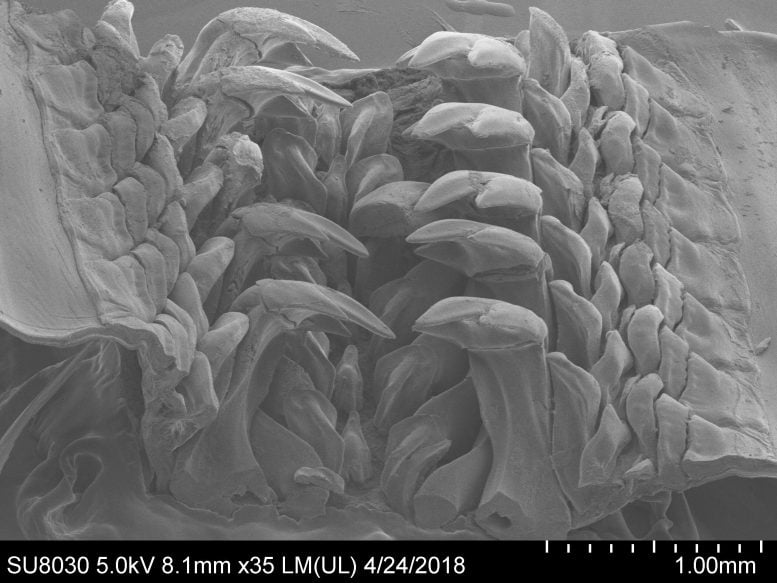
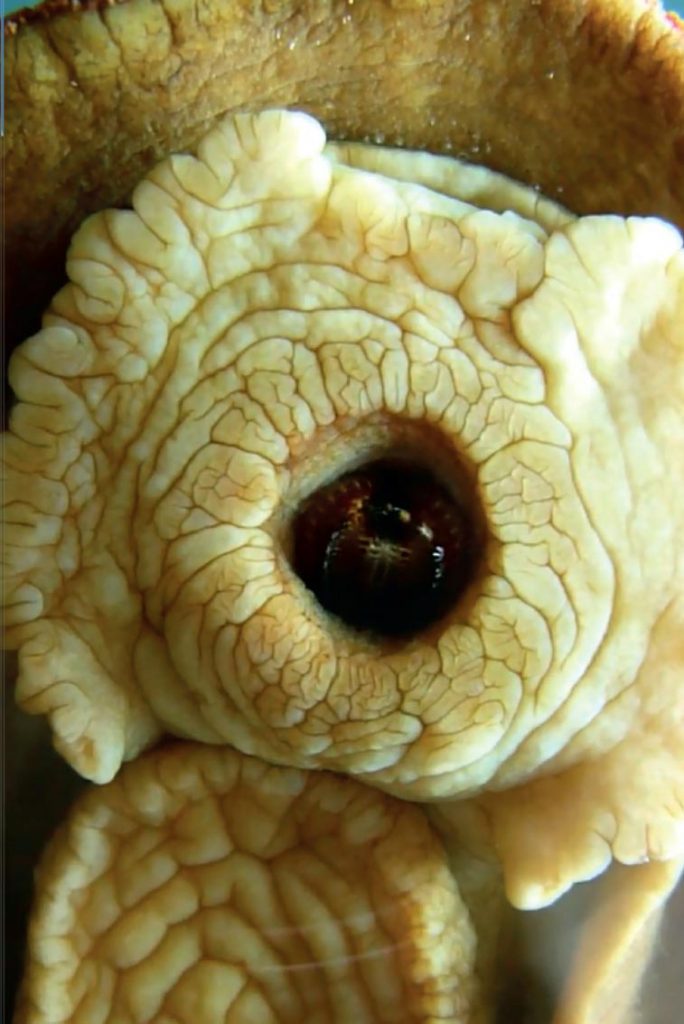
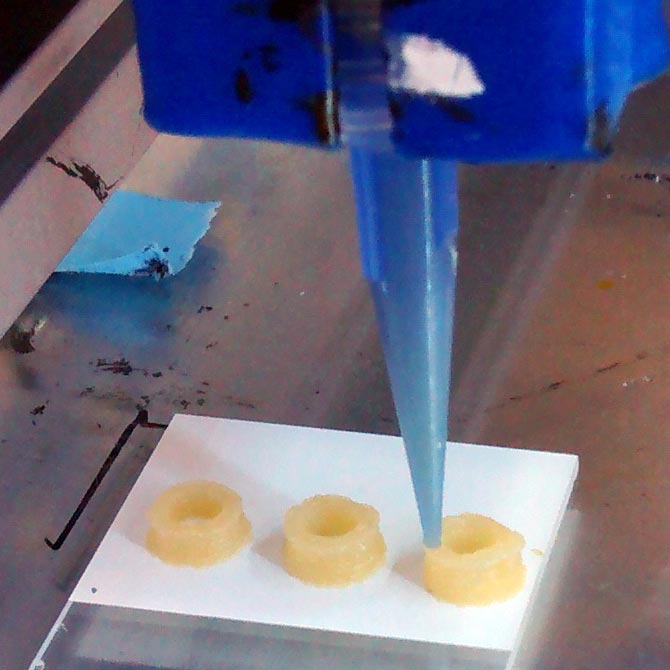


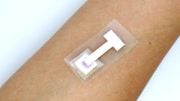
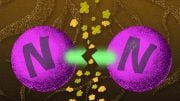
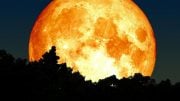

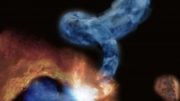

Santabarbaraite (LOL wonder where it was isolated) Fe³+³(PO⁴)²… and FLUORAPATITE (Parrot Fish teeth) Ca5(PO⁴)³F have SOMETHING in common; although the route (root?) to hardness is different; if not SIGNIFICANT. I wonder if the substitution of Fe and a hydroxyl group (rust?) for Ca and Fluorine is an improvement or a feature of available “components” in a specialized application. Ah! Nature… always, and in all ways, testing a hypothesis. Thanks for the heads-up.
Horrifying to learn of the torture committed against mollusks simply out of fascination! There is no goal shared here that could remotely make what is happening here sensible! Shameful for any scientist to bed involved in this nightmare for sea creatures.
Go back to china Ashleeeee.
Well, looks like the chiton is about to be extinct.
” is designed to endure ” -second paragraph
Really? We’re going to say this was designed? In a scientific article? It evolved. It formed. Please dont use verbs that imply conscious intention to describe the way biological structures form.
The humanizing effect of design supersedes the dehumanizing effect of chance. To live is human – not science.
Good comment.
“designed” is indeed a poor verb, unless the writer meant ‘designed by natural selection’, which would still be an incorrect word choice.
(I feel the title is slighly misleading, while blood worms are not a source of pure copper the title of this article lead me to believe blood worms do not exist had I not already known about them)
The genus Glycera is a group of polychaetes (bristle worms) commonly known as bloodworms.
These animals are unique in that they contain a lot of copper without being poisoned. Their jaws are unusually strong since they too contain the metal in the form of a copper-based chloride biomineral, known as atacamite,[4] in crystalline form.[5] It is theorized that this copper is used as a catalyst for its venomous bite.
Mr Flanigan, copper is not a rare mineral. Santabarbaraite is. Nothing misleading about that.
Fascinating! It is exciting to think of what materials will be in the future.
Alex, “nature has a way of testing a hypothesis.” Lol
Perhaps we could use this to strengthen human teeth.
Well that species is now gonna be extinct thanks to the Chinese.
MrBlack, klb, and Ashlee my thoughts exactly… I’m reading this thinking well there goes this species as well as being grown just to harvest the material then killed… really sick to think about…
These comments reflect the demise of naturalism as a rational explanation for the origins origins of life.
Wokism in science is real. Woke science = no science.
These comments reflect the demise of naturalism as a rational explanation for the origins of life.
Heartiest congrats to the team for this discovery. I graduated from Transportation Centre with Master of Science Degree in Transportation in 1979.
Very interesting.
A lot of extremely smart people here on comments ..I highly respect these guy’s… I wish I was one . hehehe
I think Ashleee (learn how to spell) paid opposition. Haha…woke btch
At Mr.Black
So these species is now going to be extinct…. thanks to the Chinese?? Wow…I guess your one of those ppl who randomly sucker punches old Asian ladies attending church..
At DTrump.. of course your a Racist lol.. and what better name to choose than the biggest looser in history.. Racist, misogynist, Adulterer, Conman and 1st ever US president to be impeached 2x and already 2 endictment straight out of office lolol.. so the name suits you.. “lock him up” DTrump.. DDump or how about Dlilpenis.. I got it DIdiot perfect
Mr Flanigan, copper is not a rare mineral. Santabarbaraite is. Nothing misleading about that.
Run little guy run
Ashley you are a sbowflake
There is Discovery here as I am regrowing Teeth in my Research Subjects and have Studied Fe Indepth and it’s Constituents for the regrotb of Adult Teeth in human Subjects.
What’s with these oversensitive herbs in these comments?
If you let the wild just be wild, you will always have the wild but if you take the wild and do something wild, soon there will be no wild…
Y’all are talking about how “sick” and “disgusted” and “lamentable” you all feel like what the hell are you buying, wearing, and using right now? Let alone the initial objective of the discovery; it was not to purposely abolish these species
FYI Ashlee: Molluscs are incapable of feeling pain, their nervous system lacks the more complex neural architecture present in higher animals. Unlike the human child slave that probably dug up the precious conflict minerals in your phone/computer that allow you to broadcast your impulsive ignorant whining in the first place. Grow up. Stop letting PETA think for you.
You’re wrong, mollusks CAN feel pain. AIRPORT SALT ON A SNAIL BEFORE OR A SLUG? Trust me because I did when I was little and it was one of the most torturous inhumane things I’ve ever experienced or ever done to any living creature and I never did it again…. None of this I was facing an infestation in my garden that is!
The almighty God is the master designer for all these marvellous findings.
Leave them alone.
HUMANS= Destruction.
Man kind is hopeless.
I feel really elated to see so many people against this. It shows that we’re not all asleep…I love you all
As of creatures, or even humans, design themselves over time. These creatures didn’t design their teeth.
Worms that eat rocks now where all gonna die, because we won’t have nothing to crawl under.
I have that same shiny rock where a tooth broke
Could a chiton be formed from mammals? Certain people could be more phosphorus and some more gaseous. And at the right location their tans become more copper.
English to urdu translation is not good 😒
We need to know what we can grow so we can force evolution on ourselves
Killer whales are killing more and more great white sharks just for their 180lb+ liver and sometimes along with the heart and testicles, ¯\_(ツ)_/¯ I kno it’s not the same, its nature but it seems a waste.
sharkss://www.newsweek.com/great-white-shark-killer-whale-autopsy-attack-1532315
HA HA, OLD ASIAN LADY KICKS ASS, and f*** Trump and you can’t even give him credit on an economic scale. As far as mother’s becoming extinct, is anyone aware on how many miles there are throughout the damn world?
Oops, I meant mollusks lol, not mothers…
it’s funny but also sad to me that people seriously think that the engineering and “design” of life itself is merely random chance to the power of random chance. We really are near the end of the era
I’m not gonna pretend to be the smartest person ever, but if you’re genuinely upset over a mollusk being used for research, you’re an idiot
All that hoe inside your DNA.